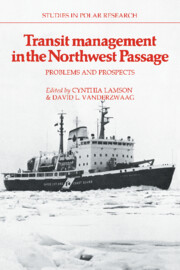Book contents
- Frontmatter
- Contents
- List of figures
- Acknowledgments
- PART I PERSPECTIVES ON THE PROBLEM
- 1 The Northwest Passage: a contrast of visions
- Post scriptum
- 2 The environment of the Northwest Passage
- 3 The development of Northern ocean industries
- 4 Arctic marine transport and ancillary technologies
- 5 Canadian arctic marine transportation: present status and future requirements
- 6 Northern decision making: a drifting net in a restless sea
- 7 Constitutional development in the Northwest Territories
- PART II PARADIGMS AND PROSPECTS
- APPENDIX: Statement on Canadian sovereignty
- CONTRIBUTORS
6 - Northern decision making: a drifting net in a restless sea
Published online by Cambridge University Press: 26 March 2010
- Frontmatter
- Contents
- List of figures
- Acknowledgments
- PART I PERSPECTIVES ON THE PROBLEM
- 1 The Northwest Passage: a contrast of visions
- Post scriptum
- 2 The environment of the Northwest Passage
- 3 The development of Northern ocean industries
- 4 Arctic marine transport and ancillary technologies
- 5 Canadian arctic marine transportation: present status and future requirements
- 6 Northern decision making: a drifting net in a restless sea
- 7 Constitutional development in the Northwest Territories
- PART II PARADIGMS AND PROSPECTS
- APPENDIX: Statement on Canadian sovereignty
- CONTRIBUTORS
Summary
Introduction
Fish, nets, corporations and government. Although seemingly unrelated, the four entities have much in common. By instinct, corporations desire to roam the economic sea at will, free to pursue prey – minerals, oil and gas so as to maximize profits. Such “free-swimming” entails at least three dangers. Corporations may devour one another – the monopoly problem. Corporations may overexploit the flora and fauna–environmental and social values. Or corporations may themselves flounder because of outside predations such as inflation, high interest rates or trade restrictions. Government acts as a protective net, directing corporate movement into politically desired directions.
This chapter examines the Canadian decision-making net for controlling Northern development. Section II surveys the drifting floats, the convolutions in Northern policies. Section III discusses the administrative mesh, the threads of governmental bureaucracy operating in the North. Section IV reviews the legislative mesh, the threads of federal legislation and regulations controlling industrial development. Section V views the net in action by focusing on governmental reviews of ten major industrial proposals during the past decade – the Alaska Highway Gas Pipeline, Beaufort Sea hydrocarbon development, Norman Wells Oilfield expansion, the Arctic Pilot Project, Panarctic Arctic Islands exploration, Polaris Mine, Nanisivik Mine, North Davis Strait, South Davis Strait, and Lancaster Sound drilling. The role of Cabinet, while treated tangentially, and the role of Parliament are beyond the scope of the present paper.
No one study will ever capture all the intricacies of the decision-making net.
- Type
- Chapter
- Information
- Transit Management in the Northwest PassageProblems and Prospects, pp. 153 - 250Publisher: Cambridge University PressPrint publication year: 1988
- 1
- Cited by



